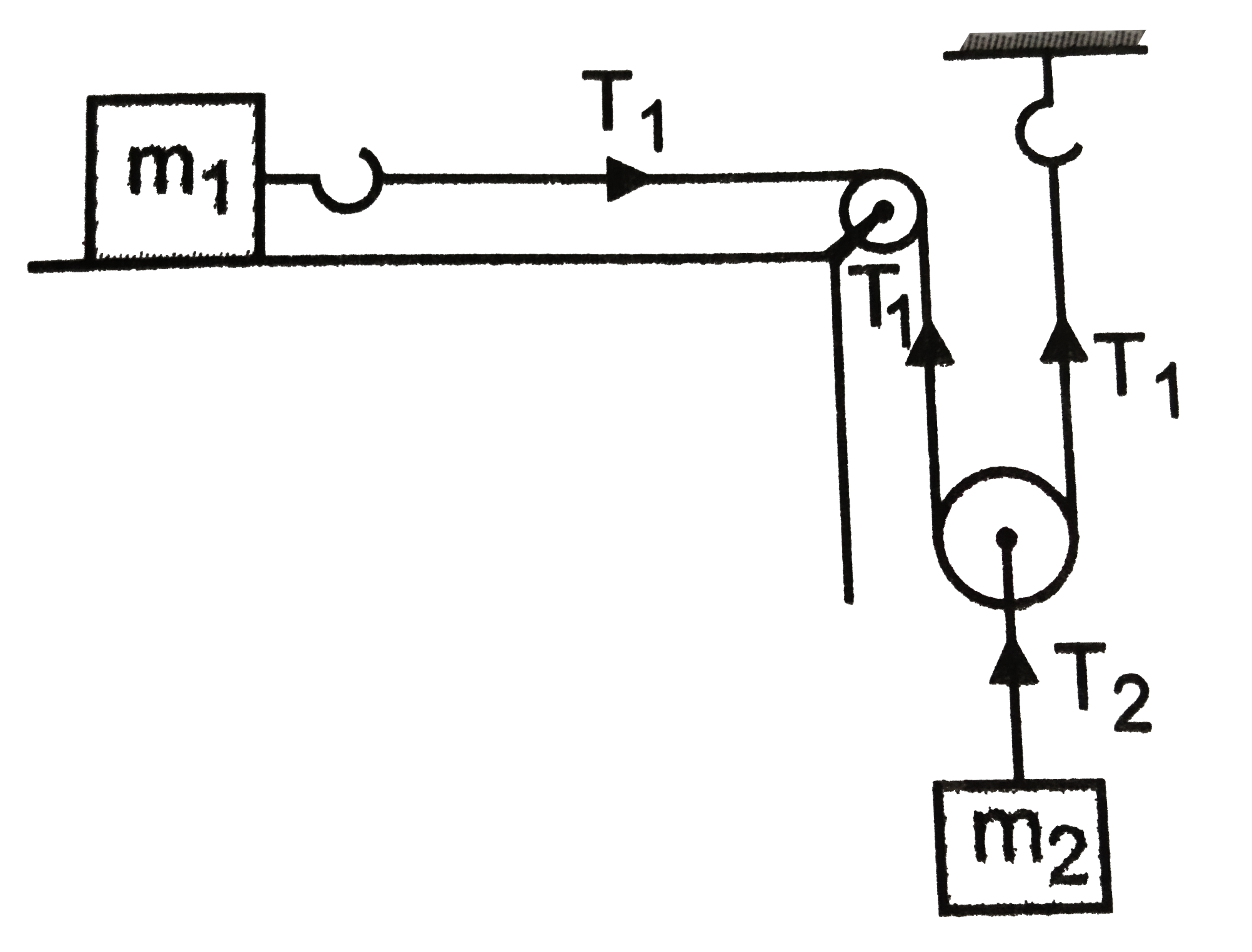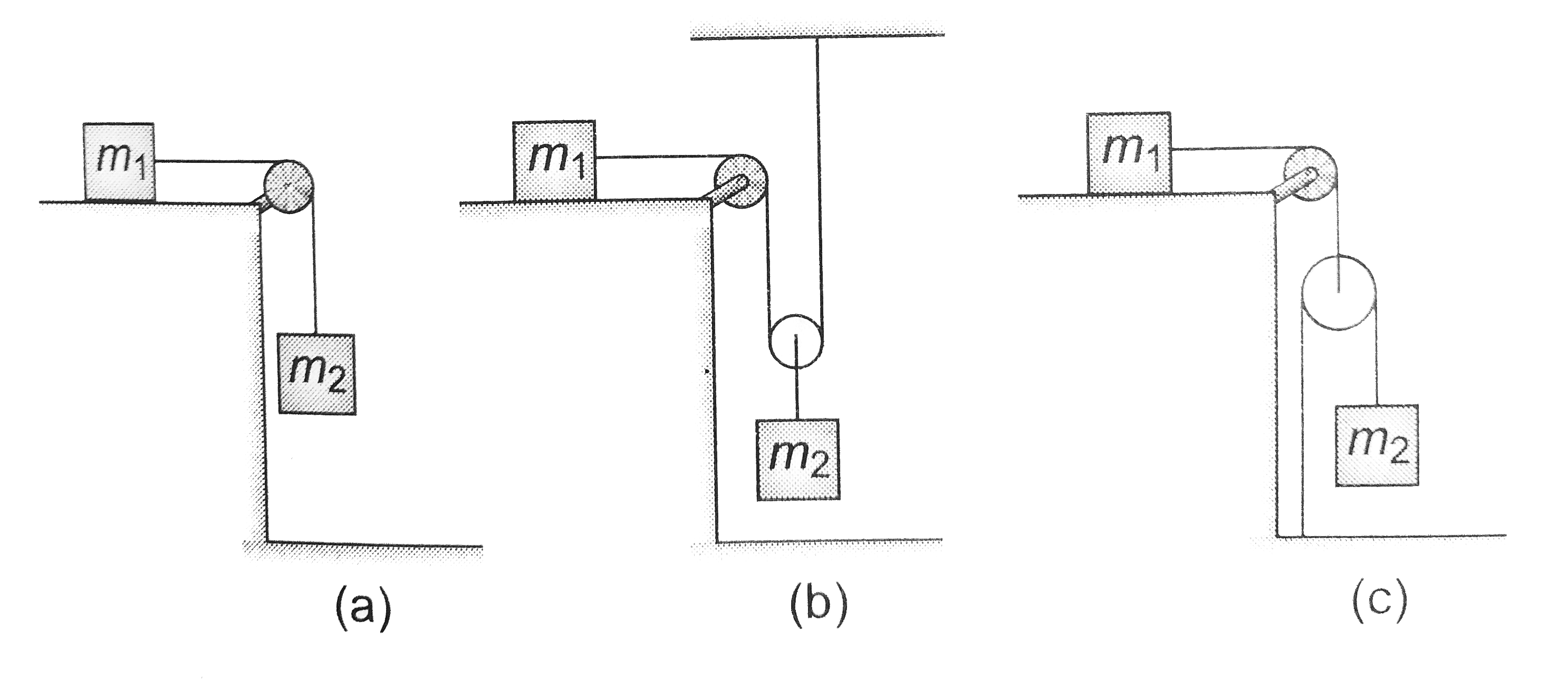When we ignore friction and mass of pulley what would be the accelerations of the two blocks m1 and m2
 .
.
The correct Answer is:a_(1) =(2m_(2) g)/(4 m_(1) + m_(2)) ;a_(2) = (m_(2) g)/(4 m_(1) + m_(2)) .
It is clear that when block m1
moves to the rigth through a distance x block m2 moves down through distance x/2 Therefore
a2=a1/2
Applying Newton s 2nd law, T1=m1a1
∴T2=2T1 Equation of motion of m2 is
m2g−T2=m2a2orm2g−T1=m2(a12)
or m2g−2m1a1=m2a12 or a1=2m2g4m1+m2
And a2=a12=m2g4m1+m2 .
Topper's Solved these Questions
- LAWS OF MOTIONBook:PRADEEPChapter:LAWS OF MOTIONExercise:JEE (Main and Advanced)/ Medical Entrance Special
Explore 93 Videos
- LAWS OF MOTIONBook:PRADEEPChapter:LAWS OF MOTIONExercise:Integer Type Questions
Explore 7 Videos
- LAWS OF MOTIONBook:PRADEEPChapter:LAWS OF MOTIONExercise:Fill in the blanks
Explore 20 Videos
- KINEMATICSBook:PRADEEPChapter:KINEMATICSExercise:1 NCERT Comprehension
Explore 4 Videos
- MATHEMATICAL TOOLSBook:PRADEEPChapter:MATHEMATICAL TOOLSExercise:Fill in the blanks
Explore 5 Videos
Similar Questions
In the arrangement shown in fig the bodies have masses m0,m1andm2 the friction is absent the masses of pulleys and the threads are negligible find the acceleration of the body m1

View SolutionTwo block of masses m1 and m2 are in equilibrium. The block m2 hangs from a fixed smooth pulley by an inextensible string that is fitted with a light spring of stiffness k as shown in fig. Neglecting friction and mass of the string, find the acceleration of the bodies just after the string S is cut.

View Solution
Knowledge Check
In each of the three arrangements, the block of mass m1 is being pulled left with constant velocity. There is no friction anywhere. The string are light and anextensible and pulleys are massless. The ratio of the speed of the block of mass m2 in the three cases respectively is:
 A2:1:4B2:4:1C4:2:1DConnot be calculated
A2:1:4B2:4:1C4:2:1DConnot be calculated
Two masses m1 and m2(m2>m1) are hanging vertically over frictionless pulley. The acceleration of the two masses is :

View SolutionA block of mass m1=2 kg is kept on a smooth horizontal table. Another block of mass m2=1 kg is connected to m1 by a light inextensible string passing over a smooth pulley as shown in the figure. If the blocks are released, what will be the (a) acceleration of each block (b) tension in the string?

View SolutionIn Fig. 10-64, block 1 has mass m1=460g, block 2 has mass m2=500g, and the pulley, which is mounted on a horizontal axle with negligible friction, has radius R = 5.00 cm. When released from rest, block 2 falls 75.0 cm in 5.00 s without the cord slipping on the pulley. (a) What is the magnitude of the acceleration of the blocks? What are (b) tension T2 and ( c) tension T1? (d) What is the magnitude of the pulley's angular acceleration? (e) What is its rotational inertia?

View SolutionIn the arrangement shown in figure the bodies have masses m0, m1, m2, the friction is absent, the masses of the pulleys and the threads are negligible. Find the acceleration of the body m1. Look into possible cases.

View SolutionFind the relation between acceleration of the two blocks m1andm2. Assume pulleys are massless and frictionless and the strings are inextensible .

View SolutionIn the arrangement shown in the figure, the blocks have masses 3m,m and 2m, the friction is absent, the masses of the pulleys and the threads are negligible. Find the acceleration of mass 3m.

View SolutionThree blocks, placed on smooth horizontal surface are connected by ideal string and a disc shaped pulley of radius r, and mass m. Find the accelerations of the blocks. Masses of the blocks are given as M1=10kg,M2=5kg,M3=2kg,m=2kg.

View Solution

